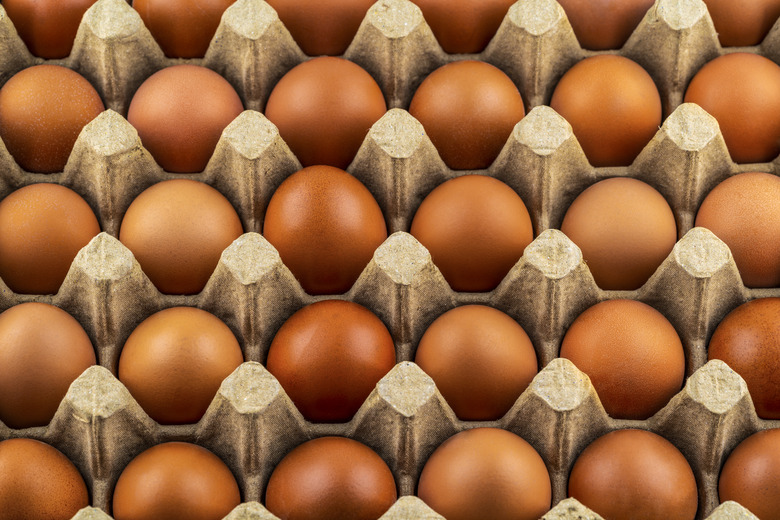Little Giant Incubator 9200 Instructions
Things Needed
- Eggs
- Lead pencil
- Surge protector
- 110-volt ground fault circuit interrupter protected outlet
The Little Giant Still Air Incubator 9200 is used to hatch eggs by raising the normal room temperature to an appropriate hatching heat. It has the capacity to hold 118 quail eggs, 40 duck or turkey eggs, 90 pheasant eggs or 46 chicken eggs. At the appropriate hatching temperatures and depending upon species, eggs hatch after 17 to 28 days in the Little Giant Still Air Incubator 9200.
To use this tool, we highly recommend that you read the Little Giant Incubator manual. However, this guide will give you a general understanding of the Little Giant Egg Incubator and what it's used for.
Step 1
Install the Little Giant Egg Incubator 9200 in a room with a temperature between 65 and 72 degrees Fahrenheit. Place it in an area void of wind drafts or direct sunlight.
Step 2
Plug the power cord into a surge protector. Plug the surge protector into a 110-volt ground fault circuit interrupter protected outlet.
Step 3
Regulate the Little Giant Egg Incubator temperature. Turn the thermostat control knob fully clockwise until the red indicator light turns on. When the thermometer reaches the egg species-appropriate hatching temperature, turn the control knob slowly counter-clockwise until the desired temperature is maintained.
Step 4
Run the incubator for six to eight hours at the desired temperature before adding eggs.
Step 5
Fill the moisture rings at the bottom of the incubator with water. This will keep the eggs moist after they are added.
Step 6
Use a lead pencil to draw an X on one side of each egg and an O on the other side of each egg.
Step 7
Lay the marked eggs horizontally on the incubator's wire mesh screen. Close down the top of the incubator so the thermometer is on top of the eggs and can be read through the window.
Step 8
Roll the eggs with the palm of your hand from the center outward and from the edges to the center of the incubator mesh screen two to three times per day after – Day 1 of the incubation period. Your X and O markings will help you remember which eggs were rolled. Do this up until three days before hatching.
Step 9
Remove both of the incubator's ventilation plugs three days before hatching. Keep the moisture rings filled to increase humidity. Open the incubator when the chicks are hatched.
TL;DR (Too Long; Didn't Read)
Store eggs at 50-55 degrees Fahrenheit until ready to incubate.
Wash hands with antibacterial soap and water before handling eggs.
Attempt to hatch only one egg species at a time.
Eggs need two to three hours to reach incubation temperature.
The Little Giant Still Air Incubator 9200 is compatible with the Little Giant Model 6300 Automatic Egg Turner.
During the incubation process, keep the moisture rings filled with lukewarm water.
As eggs begin to hatch, remove one of the red, plastic vent plugs at the top of the incubator for air exchange.
Chicken, bobwhite quail, [duck](https://sciencing.com/ducklings-8542704.html) and pheasant eggs hatch at 99.5 degrees Fahrenheit.
Turkey and cortunix quail eggs hatch at 99 degrees Fahrenheit.
Warning
Do not open the incubator on the first day of incubation.
We urge you to read the Little Giant Incubator manual along with this general guide. This cannot replace the information found in the Little Giant Incubator manual.
Used for a Little Giant Egg Incubator
Used for a Little Giant Egg Incubator
A tool of this caliber and power will most often be used for farming. This could be used in order to breed particular types of chickens for meat, eggs, feathers, competition, etc.
However, some use it for educational purposes. You may find these incubators are farming schools, colleges, universities, teaching farms, secondary schools, high schools, etc.
You may also see them at fairgrounds or chicken breeding competitions as well. It's easy to apply schooling on the life cycle of farm animals, like chickens, and then see how eggs hatch in an incubator and visually watch the life cycle occurring.
Cite This Article
MLA
McLeod, Sarah. "Little Giant Incubator 9200 Instructions" sciencing.com, https://www.sciencing.com/how-8056456-little-giant-incubator-9200-instructions/. 22 November 2019.
APA
McLeod, Sarah. (2019, November 22). Little Giant Incubator 9200 Instructions. sciencing.com. Retrieved from https://www.sciencing.com/how-8056456-little-giant-incubator-9200-instructions/
Chicago
McLeod, Sarah. Little Giant Incubator 9200 Instructions last modified March 24, 2022. https://www.sciencing.com/how-8056456-little-giant-incubator-9200-instructions/
